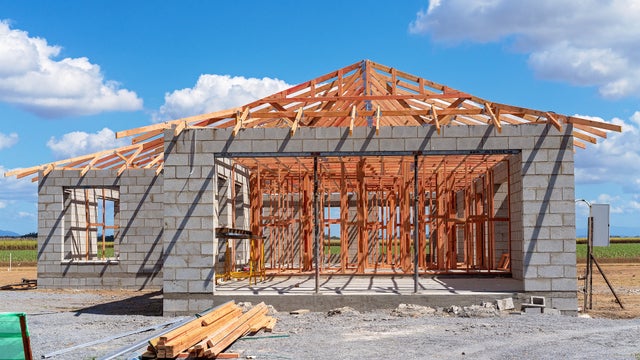Recently, the government announced new measures aimed at increasing the housing supply and improving housing affordability. They include a broad mix of new funding measures and tax revisions. Controversially, the new housing package takes aim at investors, which has provoked much debate from both sides of the political divide.
However, in the face of unsustainable double-digit house price growth over the past year, the government hopes that its new measures will promote new building and help first home buyers (FHBs) onto the property ladder.
Canstar looks at what’s in the government’s new housing package, and what it means for first home buyers.
Government’s $3.8bn Housing Package: Help for First Home Buyers. In this article, we cover:
- Housing Package: what is the Housing Acceleration Fund?
- What are the bright-line test changes in the new housing package?
- What are the new rules on mortgage interest deductions?
- Help for FHBs: what are the increased First Home Loan price caps?
- What does it all mean for first home buyers?
Housing package: what is the Housing Acceleration Fund?
To increase the supply of houses, and therefore improve home affordability, the government’s new $3.8bn Housing Acceleration Fund aims to unlock land and to help fund the infrastructure associated with building new homes, for example, new roads, sewage systems, etc.
The key components:
- An infrastructure fund, to unlock a mix of private sector and government developments
- Additional funding for the government’s Land for Housing Programme, to accelerate development of vacant/underutilised Crown-owned land
In addition, the government is also:
- Creating a new Kāinga Ora land programme, to buy more land and increase the scale of new mixed-housing developments featuring more affordable housing
- Redirecting $350m from a Residential Development Response Fund, which was set up to help the construction sector during COVID-19, to help fund more affordable homes

What are the bright-line test changes in the new housing package?
The bright-line test is a piece of legislation aimed at curbing property speculators buying and flipping houses for quick capital gains. It acts as a kind of capital gains tax. Currently, if you buy a property that is not your main home and sell it within five years you will pay income tax on any profits.
Under the proposed new legislation, the five-year period will double to ten years. The aim is to further discourage investors from looking for short-term capital gains in the property market. The new extension rule applies to all property bought from 27 March, 2021.
What are the new rules on mortgage interest deductions?
The changes to the way tax is charged on mortgages for investment properties is the most controversial part of the government’s new housing package.
Currently, when property investors calculate their taxable income, they can deduct the mortgage interest repayments on their investment properties as an expense. This reduces the tax they pay.
The government plans to change these tax breaks for investors and to phase them out over the next four tax years. Importantly, the new tax legislation will apply retrospectively, to all investors, regardless of when they bought their properties. This adds up to thousands of dollars of extra costs per year on an average investment property bought with a mortgage.

Help for FHBs: what are the increased First Home Loan price caps
While the Housing Acceleration Fund aims to increase supply. And the extension to the bright-line test and new tax rules aim to curb investors, the third part of the government’s legislation is aimed directly at first home buyers.
From April 1, the income caps for the First Home Loan and the house price caps under the First Home Grant scheme will increase.
Under the First Home Loan scheme, borrowers are now eligible for a home loan with just a 5% deposit if they earn under $95,000 a year for one person, or under $150,000 for two or more people buying together. This is up from the previous figures of $85,000 and $130,000, respectively.
Under the First Home Grant and First Home Loan schemes, the new house prices are:
|
Region |
Existing Property Cap |
New Property Cap |
|
Auckland |
$625,000 | $700,000 |
|
Queenstown-Lakes District |
$600,000 |
$650,000 |
|
Wellington City, Hutt City, Upper Hutt City, Porirua City, Kāpiti Coast District |
$550,000 |
$650,000 |
|
Nelson City, Tasman District, Tauranga City, Western Bay of Plenty District, Hamilton City, Waipā District, Hastings District, Napier City |
$525,000 |
$600,000 |
|
Christchurch City, Selwyn District, Waimakariri District |
$500,000 |
$550,000 |
|
Waikato District, Dunedin City |
$425,000 |
$550,000 |
| Rest of New Zealand | $400,000 |
$500,000 |
What does it all mean for first home buyers?
On paper, the equation does seem to add up:
Fewer property investors in the market + More houses + More financial help for FHBs = more FHBs buying property
However, the housing market in New Zealand has multiple inputs. Interest rates, immigration, the availability of land, the cost of raw building materials and labour supply in the building industry also have a big impact on house prices.
Over the past year, in part due to the low interest-rate environment, national house prices have risen 23%. So even if they were to suddenly plummet by a quarter, FHBs would still be no better off than they were a year ago. And, back then, nobody was saying FHBs had it easy.
But we can hope the new legislation will at least act as a circuit-breaker on rampant house price inflation. Indeed, this is what the government intends. And, as new supply comes online and interest rates slowly move back up again, as they inevitably will, over the next few years, FHBs will start to feel, once again, that owning a home is something within their reach.
In the market for a home loan, Canstar can help?
If you’re considering buying a property, Canstar can help make the process a little easier. Our free and easy-to-use comparison tool covers all the major players in the home loan market. Not only does it help you quickly and easily find the products with the lowest rates, it also shows which lenders and mortgages have earned Canstar’s prestigious Star Ratings, awarded on the basis of our expert analysis.
To read more about our five-star home loan awards click here, or to compare rates using our free mortgage comparison tool hit this button:
Compare home loan rates for free with Canstar!
Enjoy reading this article?
You can like us on Facebook and get social, or sign up to receive more news like this straight to your inbox.
By subscribing you agree to the Canstar Privacy Policy




Share this article